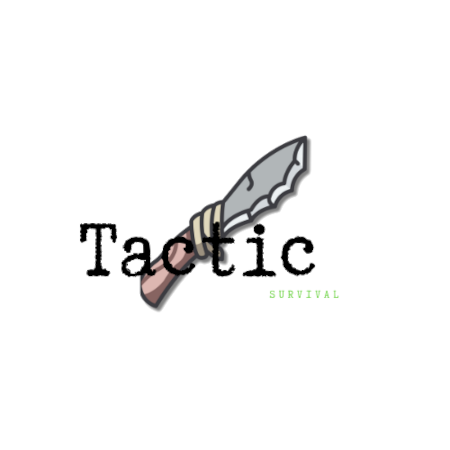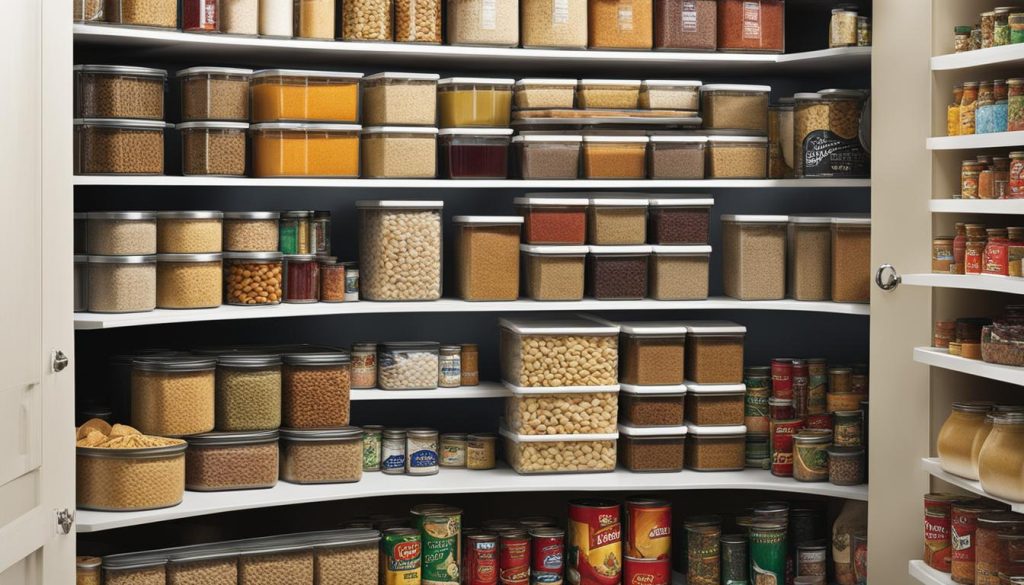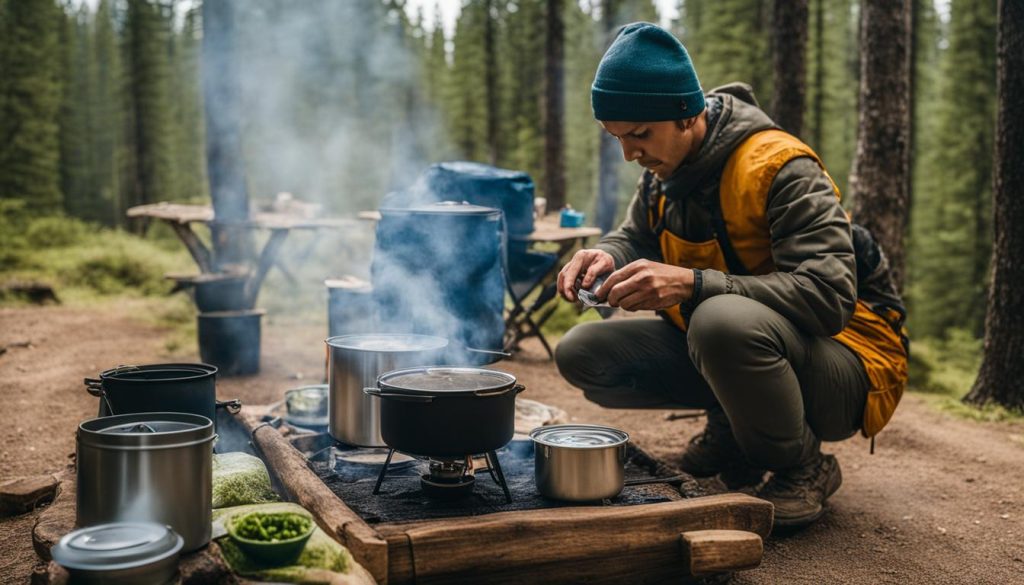Did you know that approximately 60% of American households do not have an emergency food supply plan in place?
When preparing for an emergency, it is crucial to have a well-crafted emergency food supply plan. This plan should include a variety of non-perishable items and survival essentials that can sustain you and your family during any crisis. Additionally, proper stockpile maintenance is essential to ensure the longevity and effectiveness of your emergency food supply.
Key Takeaways:
- An estimated 60% of American households do not have an emergency food supply plan.
- An emergency food supply plan should include non-perishable items and survival essentials.
- Proper stockpile maintenance is crucial for the effectiveness of your emergency food supply.
Consider Nutrition Needs and Meal Planning for Your Emergency Food Supply
When planning your emergency food supply, it’s important to prioritize nutrition. Ensuring that you and your family have access to a variety of nutritious meals and snacks is essential for overall well-being, especially during challenging times. By incorporating a balanced diet into your emergency food supply, you can provide your bodies with the necessary nutrients to stay healthy and resilient.
One helpful resource to guide your meal planning is MyPlate. Developed by the United States Department of Agriculture, MyPlate offers guidelines on portion sizes and the five essential food groups: fruits, vegetables, grains, protein, and dairy. Use this tool to ensure that your emergency meals encompass a range of nutrients from each food group.
Start by assessing the staple foods already available in your pantry. Take inventory and consider how to utilize these items in your meal planning. Having a list of meals and snacks for each day can help you map out your food supply, ensuring that you have enough to sustain your family’s dietary needs.
Sample Meal Planning
- Day 1:
- Breakfast: Oatmeal topped with dried fruit and nuts
- Lunch: Canned tuna salad with whole grain bread
- Dinner: Rice and beans with canned vegetables
- Day 2:
- Breakfast: Pancakes with canned peaches
- Lunch: Peanut butter and jelly sandwich with carrot sticks
- Dinner: Canned chicken noodle soup with crackers
- Day 3:
- Breakfast: Cereal with powdered milk and dried berries
- Lunch: Pasta salad with canned vegetables and vinaigrette dressing
- Dinner: Instant mashed potatoes with canned corn and canned chicken
Remember to include snacks throughout the day, such as dried fruits, granola bars, and nuts. These portable options provide an extra boost of energy and can be easily stored in your emergency kit.
By considering the nutrition needs of your family and incorporating meal planning into your emergency food supply, you can ensure that everyone remains well-nourished during challenging times. A well-balanced diet is key to maintaining physical and mental strength, keeping you ready to face any adversity.
Selecting Non-Perishable Items and Storage Tips for Your Emergency Food Supply
When preparing your emergency food supply, it’s crucial to select non-perishable items that can withstand extended storage periods without spoiling. These items not only provide sustenance during emergencies but also offer convenience and peace of mind. Here are some tips for choosing the right non-perishable items and ensuring proper storage:
1. Consider Options that Require Little to No Preparation
When stocking up on non-perishable items, opt for foods that are ready to eat or require minimal preparation. Canned goods, such as vegetables, beans, and meats, are excellent choices as they can be consumed directly from the can or easily heated on a stove. Dehydrated or freeze-dried foods, such as fruits, vegetables, and meals, are lightweight, compact, and have a longer shelf life. Additionally, heat-and-serve meals, such as prepackaged soups and stews, are convenient options that only require heating before consumption.
2. Store Food in a Dry, Cool Spot
Proper storage is crucial for preserving the quality and longevity of your emergency food supply. Find a dry, cool spot in your home to store your non-perishable items. Avoid areas exposed to direct sunlight or high temperatures as they can accelerate food spoilage. Choose a pantry, basement, or closet away from heat sources, such as radiators or water heaters, to maintain an optimal temperature for extended shelf life.
3. Use Airtight Containers for Perishable Items
Some non-perishable items, such as cookies, crackers, and cereals, may become stale if not properly stored. To prevent this, transfer these items to airtight containers once opened. Airtight containers create a barrier against moisture and pests, maintaining the freshness and crispness of these perishable items for longer periods. Label each container with its content and date of storage for easy organization and rotation.
4. Check for Signs of Spoilage
Regularly inspect your non-perishable items for signs of spoilage to ensure your emergency food supply remains safe and of high quality. Check canned goods for any swollen, dented, or corroded cans, as these are signs of bacterial growth and compromise the contents. If you encounter any compromised cans, discard them immediately. Familiarize yourself with the expiration dates on your non-perishable items and rotate your food supply regularly, placing newer items at the back and using older ones first.
Following these guidelines will help ensure that your emergency food supply is well-stocked and properly stored, ready to sustain you and your family during times of crisis. By selecting the right non-perishable items and implementing effective storage practices, you can have peace of mind knowing that you’re prepared for any emergency.
Water Considerations and Important Tips for Emergency Food Planning
When it comes to emergency food planning, water is a crucial consideration. Adequate access to clean drinking water is essential for the well-being of you and your family during any crisis. Water considerations should be an integral part of your emergency food supply plan to ensure you have enough water for drinking, cleaning, and cooking purposes.
“Water is life’s most necessary ingredient, and without it, survival is not possible. In emergency situations, being prepared with clean drinking water can make all the difference.”
It is recommended to store at least one gallon of water per person, per day for emergency situations. This will ensure you have an adequate supply for all essential needs throughout the duration of the crisis. This includes water for drinking, cooking, personal hygiene, and cleaning.
Bottled water is an excellent option for long-term storage as it has a longer shelf life and is easily portable. However, it can be supplemented with tap water if needed. If using tap water, make sure to store it in food-grade containers that are properly sanitized and sealed to prevent contamination.
In addition to stored water, it is important to be aware of potential water sources in your home that can be used in emergencies. Hot water tanks and pipes can potentially provide access to water when the regular water supply is unavailable. However, it is essential to treat this water before consumption to ensure its safety.
In certain situations, it may be necessary to explore outdoor water sources such as rainwater, streams, or ponds. However, it is critical to remember that these water sources may be contaminated. Always treat the water using appropriate filtration or purification methods before drinking or using it for cooking.
Overall, having a reliable and safe water supply is essential for successful emergency food planning. By considering water considerations alongside your food supply plan, you can ensure the well-being and survival of yourself and your loved ones during challenging times.
Cooking and Food Safety Tips for Emergency Situations
In emergency situations, cooking without traditional kitchen appliances becomes necessary. Here are some essential cooking tips and food safety guidelines to help you navigate such circumstances:
1. Alternative Cooking Methods
When traditional kitchen appliances are unavailable, consider alternative cooking methods like utilizing a fireplace or outdoor cooking devices such as propane stoves or grills. These options can provide a means to prepare meals during emergencies. However, always prioritize safety and remember to use outdoor cooking devices exclusively outdoors to prevent carbon monoxide poisoning.
2. Proper Handling of Canned Food
Eating canned food directly from the can is common in emergency situations. However, it is crucial to thoroughly wash the can before consumption to eliminate any potential germs or bacteria. This simple step helps maintain food safety standards and minimizes the risk of foodborne illnesses.
3. Hygiene and Cleanliness
Maintaining proper hygiene while cooking and eating is essential in emergency situations. Clean cooking utensils and eating utensils diligently to prevent contamination. Use hot, soapy water or disinfectant solutions when possible. Additionally, dispose of empty containers and leftover food promptly, preferably outdoors, to keep your living space sanitary.
4. Food Storage and Preservation
Proper food storage and preservation play a crucial role in emergency situations. If refrigeration is unavailable, prioritize the consumption of perishable items to reduce the risk of spoilage. Monitor food temperatures and discard anything that appears spoiled or has an off odor.
Consider organizing your emergency food supply using the first-in, first-out (FIFO) method. Rotate your stock periodically by placing newer items at the back and using older ones first. This strategy ensures that your emergency food supply remains fresh and edible for an extended period.
| Cooking and Food Safety Tips for Emergency Situations |
|---|
| Use alternative cooking methods like fireplaces or outdoor devices. |
| Thoroughly wash canned food before consumption. |
| Maintain hygiene by cleaning cooking and eating utensils. |
| Dispose of empty containers and leftover food promptly. |
| Store and rotate food supply using FIFO method. |
By following these cooking tips and food safety guidelines, you can ensure the well-being of yourself and your loved ones during emergency situations.
Conclusion
When it comes to disaster preparedness, having a strong emergency food supply plan is essential. By considering nutrition needs, selecting non-perishable items, ensuring proper storage, and understanding cooking and food safety tips, you can be well-equipped for any emergency situation.
Regularly reviewing and updating your emergency food supply is crucial to maintain readiness and ensure the well-being of you and your loved ones. Disaster preparedness is an ongoing process, and by staying vigilant and making necessary adjustments, you can adapt to changing circumstances and remain prepared for any unexpected event.
Remember, disaster readiness strategies go beyond just having food supplies. It’s important to create a comprehensive emergency plan that covers all aspects of safety and well-being. This includes having a communication plan, first aid and medical supplies, emergency shelter, and knowing evacuation routes. Being prepared for emergencies requires proactive planning and a holistic approach to ensure the best possible outcome in any situation.


